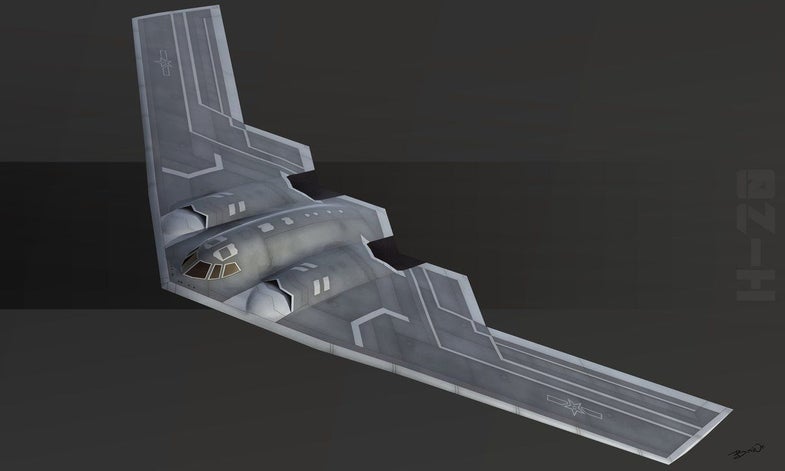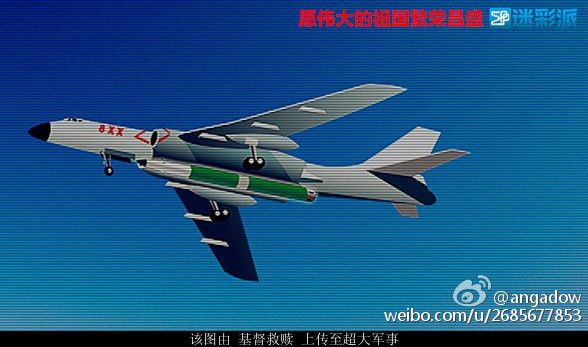China has big plans for a modern bomber
The H-20 is China’s future stealth bomber.


H-6K
China’s defense industry has been rapidly modernizing, though a few key gaps still lie between the nation and its bid to become a major military power. One such gap: a long-range bomber.
Right now, Xian Aircraft Corporation (XAC) builds the H-6K, a version of the 1950s Soviet Tu-16 Badger medium bomber modernized for avionics and increased range. But a series of reports demonstrate that, along with fielding modern missiles and expanding its range of military activities across the Pacific Ocean, China is planning to build out its strategic bomber force with a new generation of planes.

Air Delivery
After years of speculation, in September 2016 People’s Liberation Army Air Force commander General Ma Xiaotian announced that China was researching the development of a long-range bomber. The news was reflected in the 2017 U.S. Defense Department Annual Report on the Chinese Military, which said China was developing a strategic bomber with a “nuclear mission.”

H-20
The future strategic bomber, tentatively identified by Chinese Internet commentators as H-20, is believed to be a flying wing bomber designed for range and stealth and built by XAC. Since the H-20 needs to have a range of around 6,200 miles in order to strike strategic intercontinental targets while carrying a useful payload of 10-20 tons, it will need four turbofan engines. Those turbofan engines are likely to be non-afterburning versions of the WS-10 engine, which would provide about 8 tons of thrust.
All that would make the H-20 similar in size to the the United States’ B-2 by Northrom Grumman, a craft that also has four 8-ton engines. It would be armed with bombs and, likely, systems like the 1,200-mile-range CJ-10 land attack cruise missiles, which would be carried in internal weapon bays. Future weapons could include GB-6A stealth cruise missiles and hypersonic scramjet missiles.

Sharp Sword Flight
It’s also possible that the H-20 could act like an airborne command, particularly given China’s recent research in ‘centaur’ unmanned and manned aircraft teaming and datalinking of sensor nodes with long-range missiles. The U.S. Air Force has reported plans of the same role for the B-21 Raider stealth bomber.

JH-XX
The H-20 concept is often confused with another of China’s nebulous future aircraft, a supersonic regional-ranged bomber known as JH-XX. That’s a totally separate bomber, but still worth highlighting here. First seen in model form at airshows in 2013, the JH-XX (which has not been confirmed by officials) was reported to have an 80-100-ton takeoff weight and supersonic capabilities. The 30-meter-long aircraft looks to have a main weapons bay under the central fuselage for carrying armaments like anti-ship missiles (such as the YJ-12), as well as two weapon bays on either side of the fuselage that could carry air-to-air missiles like the PL-15 and PL-10. Its reported 1,500-mile combat radius would be enough to strike U.S. carriers and even bases like Guam. That all being said, whoever’s building it might have problems finding supersonic turbofan engines that are large enough.
The JH-XX would have been most similar in mission profile to the Russian Tu-22M Backfire bomber, another supersonic regional bomber designed to attack enemy aircraft carriers nearing the homeland. But unlike the Tu-22M, the JH-XX could be armed with air-to-air missiles to fire back at enemy interceptors and missiles. Still, unlike the H-20, there has been no official mention of an aircraft with the JH-XX’s profile from either American or Chinese sources.

H-6N
Of course, this is all informed speculation, and it’s unclear what kind of success these future-facing developments will really have. In the short-term, China’s strategic air deterrent is being modernized in another novel manner: via an air-launched ballistic missile (ALBM). The ALBM, according to U.S. Defense Department sources, is a variant of the DF-21 medium-range ballistic missile, with improvements increasing its range to about 1,800 miles. The Chinese ALBM will be carried by a modified variant of the H-6K, the H-6N, which has a refueling probe to increase its range to 3,700 miles.
Peter Warren Singer is a strategist and senior fellow at the New America Foundation. He has been named by Defense News as one of the 100 most influential people in defense issues. He was also dubbed an official “Mad Scientist” for the U.S. Army’s Training and Doctrine Command. Jeffrey is a national security professional in the greater D.C. area.